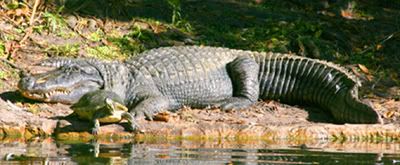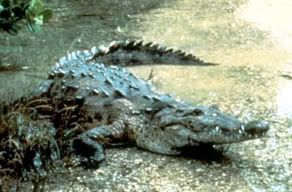American Alligator, (Alligator mississippiensis), is found in freshwater throughout the state. It has a large (10-19′) black body with a broad, rounded snout and lives an average of 40 years.
The American Alligator is the official state reptile and the mascot of the University of Florida.
It has excellent eyesight even at night. Its jaws hold 70-80 pointed teeth. If a tooth is lost, a new one grows in its place. It feeds on fish, turtles, water birds, snakes, frogs, and small mammals.
The alligator swims by tucking its legs against its body and sweeping its tail from side to side. It is capable of sudden bursts of speed in the water and on land.

Active during warmer months, alligators may stay secluded underwater or in shoreline dens during colder months. If resting, they can stay underwater for an hour or even several hours. They tend to wander during droughts and mating season.
Scan the surface of a lake at night with a strong flashlight. A red glow is the light reflected from an alligator’s eyes. A green or yellow glow indicates a frog or water spider.
Hunted almost to extinction, alligator hunting was banned in the early 1960’s, and is now strictly regulated.
Alligators bellow, loudly! Apparently gators bellow for the sheer sake of bellowing, it hasn’t been linked to hostile or mating behaviours. Just before a male bellows, he performs a “water dance”, vibrating his whole torso. At the same time, he issues low notes, too low to be heard by humans, that can be heard by other alligators at long distances. Females bellow but not as loudly. Females grunt to call their young. All alligators hiss.
Spring courtship usually takes place in early April. In June or July, the female builds a nest of dirt and plant debris 2-3 feet high near water. She hollows out a cavity, lays the eggs (30-50), and covers them up. She aggressively guards the nest, often resting her chin on top of it. About 70 days later, the broods hatch, usually emerging from the nest with the help of the mother, and head straight for the water. Black with yellow bands, the hatchlings are 8-9 inches long. They stick together, forming a “pod”, for at least a year.
Like crocodiles and most turtles, alligators lack sex chromosomes. The sex of the offspring is determined by the incubation temperature of the eggs. Alligator eggs that incubate at 82-86°F become females and those at 90-93°F become males. Eggs that incubate in the middle range result in an equal number of males and females.
Brown Caiman, (Caiman crocodylus), is an introduced species found in canals in the Miami area. It is greenish gray to brownish gray with dark brown bands and has a bony ridge in front of the eyes. It may grow to 6 feet long.
It is native to Central and South America. The populations in Florida are probably the result of pet caimans being released.
American Crocodile, (Crocodylus acutus), is found in along saltwater shorelines in extreme south Florida. Most of Florida’s few hundred crocodiles live along the southern shores of the Everglades. Juveniles are marked by bands but adults, which may grow to 15 feet in length, are slate gray with little or no patterning. The snout of the crocodile is longer and narrower than that of the alligator. When the mouth is closed, a large tooth in the lower jaw is visible.
Crocodiles make a growling or rumbling sound. Juveniles make a high-pitched grunt.
The diet includes water birds, small mammals, terrapins, crabs, and fish.
In late April or May, the female builds a nest, about 2 feet tall and 5-10 feet in diameter, of sand and shell. She hollows out a cavity, lays 20-80 eggs, and covers them up. She will flee, perhaps abandoning the nest, if approached. When the eggs hatch about 100 days later, the hatchlings make croaking soaks, alerting the female who will dig them out of the nest and possibly carry them to the water.


No comments yet.